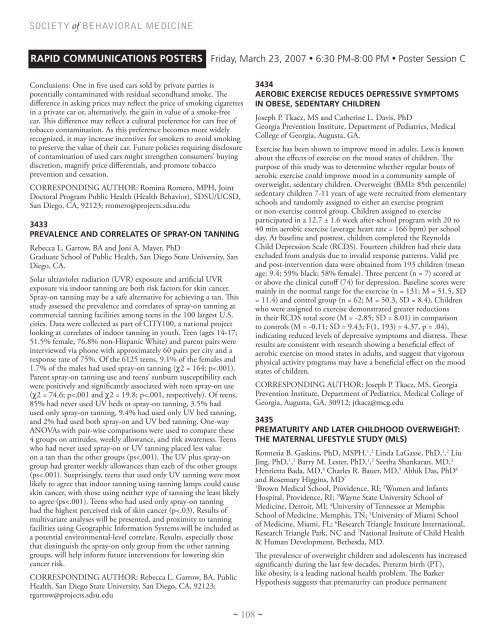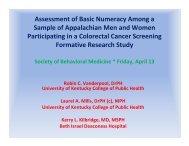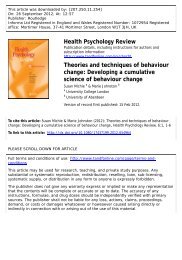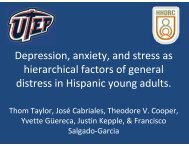2007 Final Program - Society of Behavioral Medicine
2007 Final Program - Society of Behavioral Medicine
2007 Final Program - Society of Behavioral Medicine
Create successful ePaper yourself
Turn your PDF publications into a flip-book with our unique Google optimized e-Paper software.
SOCIETY <strong>of</strong> BEHAVIORAL MEDICINE<br />
Rapid Communications Posters Friday, March 23, <strong>2007</strong> • 6:30 PM-8:00 PM • Poster Session C<br />
Conclusions: One in five used cars sold by private parties is<br />
potentially contaminated with residual secondhand smoke. The<br />
difference in asking prices may reflect the price <strong>of</strong> smoking cigarettes<br />
in a private car or, alternatively, the gain in value <strong>of</strong> a smoke-free<br />
car. This difference may reflect a cultural preference for cars free <strong>of</strong><br />
tobacco contamination. As this preference becomes more widely<br />
recognized, it may increase incentives for smokers to avoid smoking<br />
to preserve the value <strong>of</strong> their car. Future policies requiring disclosure<br />
<strong>of</strong> contamination <strong>of</strong> used cars might strengthen consumers’ buying<br />
discretion, magnify price differentials, and promote tobacco<br />
prevention and cessation.<br />
CORRESPONDING AUTHOR: Romina Romero, MPH, Joint<br />
Doctoral <strong>Program</strong> Public Health (Health Behavior), SDSU/UCSD,<br />
San Diego, CA, 92123; rromero@projects.sdsu.edu<br />
3433<br />
PREVALENCE AND CORRELATES OF SPRAY-ON TANNING<br />
Rebecca L. Garrow, BA and Joni A. Mayer, PhD<br />
Graduate School <strong>of</strong> Public Health, San Diego State University, San<br />
Diego, CA.<br />
Solar ultraviolet radiation (UVR) exposure and artificial UVR<br />
exposure via indoor tanning are both risk factors for skin cancer.<br />
Spray-on tanning may be a safe alternative for achieving a tan. This<br />
study assessed the prevalence and correlates <strong>of</strong> spray-on tanning at<br />
commercial tanning facilities among teens in the 100 largest U.S.<br />
cities. Data were collected as part <strong>of</strong> CITY100, a national project<br />
looking at correlates <strong>of</strong> indoor tanning in youth. Teen (ages 14-17;<br />
51.5% female, 76.8% non-Hispanic White) and parent pairs were<br />
interviewed via phone with approximately 60 pairs per city and a<br />
response rate <strong>of</strong> 75%. Of the 6125 teens, 9.1% <strong>of</strong> the females and<br />
1.7% <strong>of</strong> the males had used spray-on tanning (χ2 = 164; p

















